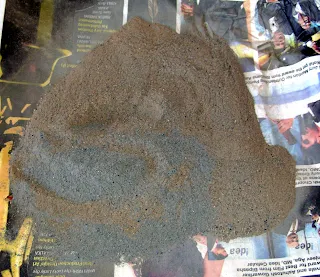Photographs: IGRMS, Bhopal
Longpi village lies at 40 kms north of Ukhrul town in Ukhrul District, Manipur. The village is inhabited by aroung 6000 Tangkhul tribe and their main occupation is agriculture and pottery. Longpi is the only village in the whole of Ukhrul District which produces blackware earthen pots. These pots are unique in quality and style also.
 |
| Fine powder of local stone containing mineral |
 |
| Local sandy clay |
 |
Mixture of crushed sandy clay and mineral stone in a ration of 2:1
|

Longpi pots, as it is popularly known in Manipur and elsewhere has been widely used in the region since time immemorial. Longpi pots are prepared in various styles, sizes and forms. The most popular variety is cooking pots (for curry) which is the prized possession of every Tangkhul household.



 Longpi pots, as it is popularly known in Manipur and elsewhere has been widely used in the region since time immemorial. Longpi pots are prepared in various styles, sizes and forms. The most popular variety is cooking pots (for curry) which is the prized possession of every Tangkhul household.
Longpi pots, as it is popularly known in Manipur and elsewhere has been widely used in the region since time immemorial. Longpi pots are prepared in various styles, sizes and forms. The most popular variety is cooking pots (for curry) which is the prized possession of every Tangkhul household.
Comments